Computational mechanistic insights on Ag2O as a host for Li in lithium-ion batteries†
Abstract
The lithiation mechanism of Ag2O with one and two Li atoms per unit cell carried out using density functional theory (DFT) studies indicate the adsorption of one Li atom at the tetrahedral interstitial site (TIS) as the most stable one with the formation of the Li–Ag2O compound. PDOS plots depict the hybridization of Li 2s with O 2p and Ag 5s states, resulting in the formation of both Li–O and Li–Ag bonds. Also, the Bader charge analysis validates the bonding of Li at TIS with both Ag and O atoms. The band structure plots showcase a surge in electronic conductivity, accounting for the metallic transition of Ag2O with the addition of Li. The difference in the charge distribution between the pairs of surface and subsurface silver atoms in charge density difference plots (CDDP) reveal the incorporation of Li, invoking charge inequivalence in addition to the symmetry inequivalence in the optimized structure. In the case of two Li atoms, Li placed on the top of oxygen (Otop) and at the subsurface of silver (Agss) was found to be the most stable structure with the formation of two strong Li–O bonds, indicating the feasibility of the conversion mechanism. The increase in the Bader charge of O (−1.28e) as well as CDDP establish the formation of Li2O by the conversion mechanism. Thus, the increase in the Li+ ion concentration becomes the deciding factor for the transition of the lithiation mechanism from Li–Ag2O compound formation to the conversion mechanism. The molecular dynamics (MD) simulations feature Li as an “antisite defect producing guest”, leading to the formation of Li–O bonds with a concomitant reduction in the number of Ag–O bonds as a function of time. This confirms a shift in the reaction kinetics from the formation of Li–Ag2O to the conversion mechanism.



 Please wait while we load your content...
Please wait while we load your content...